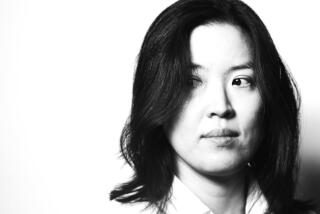The Unlikely Ones by Mary Brown (McGraw-Hill: $15.95; 425 pp.)
- Share via
Fantasy, as literature, is a strange and wondrous beast. Generally indefinable, fantasy is often perceived by mainstream readers and reviewers as little more than a collection of specific ingredients held together by storytelling.
For many, fantasy and fairy tales are mostly indistinguishable, comprised equally of evil witches, wizards, handsome princes, enchanted animals, unicorns, dragons, knights and beauteous maidens. And a love story. And, of course, numerous Quests and Curses.
Mary Brown, in her second novel, “The Unlikely Ones,” (her first book, “Playing the Jack,” was not a fantasy) makes full use of all the tried-and-true fairy-tale ingredients. She introduces the interrelated tales of a benevolent dragon who has lost the magical stones that will allow him to enter the ranks of Master Dragons, and of a unicorn who sacrifices his horn in an effort to save his beloved prince from a witch’s evil spell.
But the dragon and unicorn are only the teasers; the show doesn’t properly open until the narrator takes center stage.
Thingy is a “Hunchie,” a deformed young girl whose past is forgotten and future made bleak by the machinations of a graphically illustrated evil witch, who has bound Thingy and her compatriots--kitten, toad, crow and goldfish--into a spell designed to protect the magical stones stolen from the dragon. Each is trapped by the burden of a stone permanently embedded in flesh; their only escape is a bond of their own making, which withstands even the witch’s attempts to thwart their personal magic.
But when the witch herself is thwarted, Thingy and her animal friends are thrust abruptly into a new life. Toad in pocket, fish in bowl, cat in hand and crow on shoulder--plus two new additions: the hornless unicorn and a rusty knight--Thingy begins the classic quest to free herself and the others of the stones.
Unfortunately for longtime fantasy readers, “The Unlikely Ones” doesn’t quite succeed in terms of the contemporary genre. Brown’s writing style is vigorous and frequently lyrical, yet anachronisms and colloquialisms abound. Description is often poetic--”. . . sweet cicely pollen-powdered my knees, keck-parsley my hips, angelica my shoulders; corn-poppies, Demeter’s bane, bled at my feet and elder laced my hair . . .”--but is abruptly juxtaposed with slangy British dialogue.
As the central character, Thingy is a fascinating individual. Her narration is brisk, unaffected, compelling, and often impassioned. Through her perceptions, the reader is introduced to a complex personality whose comprehension of herself and the world around her has been blighted by evil enchantment.
And yet Brown chooses to depart from Thingy’s narrative at inopportune moments, rendering her otherwise evocative story unnecessarily disjointed. Numerous climaxes and lengthy denouements in the latter portion of the book weaken the overall impact.
The story in and of itself, while deftly told, is overly familiar. Brown breaks no new ground in the tale of two reluctant lovers entangled in enchantment, nor of presenting animals as sentient, distinctive characters with the ability to communicate. And adult fantasy fans, having suckled consistently on dragons and unicorns the last 10 years, may well find the taste has palled.
Most important, however, “The Unlikely Ones” suffers from the lack of a clearly defined audience. Although marketed as adult literature, the overall tone identifies it as a YA novel, particularly the childish names (Thingy, Snowy, Pisky, Puddy, Corby and Moglet), which, even with delineated repetition, begin to blur one into the other.
Brown’s book is clearly a “rite of passage” novel, dealing with personal growth, physical maturization, difficult choices. And yet adult themes and distinctly graphic passages may render it inaccessible to younger readers who would otherwise love the enticing animals.
“The Unlikely Ones” doesn’t really “fit.” It isn’t identifiably YA, or obviously adult. It bears little relationship to the contemporary genre, with its emphasis on gritty realism of a lyric, ephemeral quality known as high fantasy; instead, Brown’s novel harks back to childhood fairy tales and fables. It is often infinitely predictable and, consequently, occasionally laborious, yet simply reading along for the ride does offer some moving moments for those willing to go the distance.
For readers who want to curl up with an old-fashioned fairy tale (albeit with adult overtones) similar to “The Once and Future King,” this book is a must. But for others, “The Unlikely Ones” is eminently putdownable.
More to Read
Sign up for our Book Club newsletter
Get the latest news, events and more from the Los Angeles Times Book Club, and help us get L.A. reading and talking.
You may occasionally receive promotional content from the Los Angeles Times.






